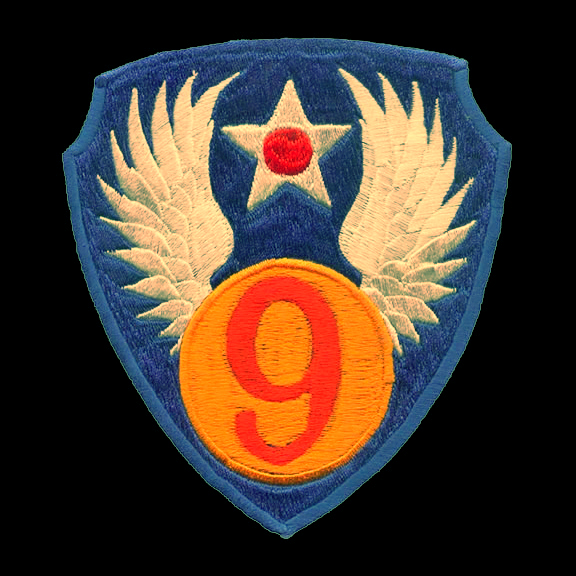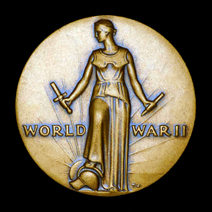 |
416th Bombardment Group (L) 9th Air Force USAAF
|
 |
Return to Table of Contents

Insigne. Shield: Azure, a bezant winged argent charged with the Arabic numeral "9" gules, in
honor point a mullet of the second bearing a torteau. (Approved 16 Sep 1943.)
The Ninth Air Force was activated on November 12, 1942 as a successor to the U.S. Army Middle East Air Forces. It originally consisted of the IX Bomber Command; the IX Fighter Command and the 316th Troop Carrier Group. The latter evolved into the IX Troop Carrier Command. The Ninth Air Force moved from the Middle East to the United Kingdom on 16 October 1943. Headquarters for the Ninth AF was established at RAF Burtonwood and the IX Bomber Command was headquartered at Marks Hall on RAF Earls Colne. On the 26th of November, 1943, the 97th Bombardment Wing (Light) was added to the IX Bomber Command with its headquarters initially at Marks Hall as well. The wing moved to Little Walden, Essex on March 13, 1944 and to France on September 13, 1944. The 97th Bomb Wing was comprised of three groups, the 409th, 410th and 416th, initially assigned A-20 Havoc bombers and by the end of 1944 the A-26 Invader. Each Group consisted of four squadrons. The 416th Bomb Group included the 668th, 669th 670th and 671st Bomb Squadrons and was stationed at RAF Wethersfield from February 1st 1944 until the unit moved to France on September 21, 1944. The Ninth AF was deactivated in December 1945 and reactivated in March 1946 as part of the new U.S. Air Force structure.


9th Air Force Commanders:
Lt. General Lewis H. Brereton
General Hoyt S. Vandenberg
(Nov 1942 - Aug 1944)
(Aug 1944 - Jul 1945)

Major General Samuel E. Anderson
Commander, IX Bomber Command (Oct '43 - May '45)

Brigadier General Edward N. Backus
Commander, 97th Bomb Wing (Mar '44 - May '45)
9th Air Force - IX Bomber Command - Order of Battle, June 6, 1944
97th Bombardment Wing (Light)
409th Bombardment Group (Douglas A-20 Havoc, later Douglas A-26 Invader)
(Bomb Group Marking:
Solid Yellow vertical stripe along the trailing edge of the tail rudder)
(American Air Museum)
(Defunct www.web-birds.com History of the 409th BG (L), via Internet Archive WayBack Machine)
640th Bombardment Squadron (W5)
641st Bombardment Squadron (7G)
642nd Bombardment Squadron (D6)
643rd Bombardment Squadron (5I)
410th Bombardment Group (Douglas A-20 Havoc, Martin B-26 Marauder, later Douglas A-26 Invader)
(Bomb Group Marking:
Alternating White and Black vertical stripe along the trailing edge of the tail rudder)
(American Air Museum)
(Defunct www.web-birds.com History of the 410th BG (L), via Internet Archive WayBack Machine)
644th Bombardment Squadron (5D)
645th Bombardment Squadron (7X)
646th Bombardment Squadron (8U)
647th Bombardment Squadron (6Q)
416th Bombardment Group (Douglas A-20 Havoc, later Douglas A-26 Invader)
(Bomb Group Marking:
Solid White (A-20's) or Solid Black (A-26's) vertical stripe along
the trailing edge of the tail rudder)
(American Air Museum)
668th Bombardment Squadron (5H)
669th Bombardment Squadron (2A)
670th Bombardment Squadron (F6)
671st Bombardment Squadron (5C)
98th Bombardment Wing (Medium)
323rd Bombardment Group (Martin B-26 Marauder)
(Bomb Group Marking:
White horizontal stripe approximately 30 inches high)
(American Air Museum, B26.com, B26.com History, 323bg.org)
453rd Bombardment Squadron (VT)
454th Bombardment Squadron (RJ)
455th Bombardment Squadron (YU)
456th Bombardment Squadron (WT)
387th Bombardment Group (Martin B-26 Marauder)
(Bomb Group Marking:
Horizontal band of alternating pattern of diagonal
yellow and black stripes of equal width)
(American Air Museum, B26.com, 387bg.com)
556th Bombardment Squadron (FW)
557th Bombardment Squadron (KS)
558th Bombardment Squadron (KX)
559th Bombardment Squadron (TQ)
394th Bombardment Group (Martin B-26 Marauder, Began A-26 Invader training post V-E Day)
(Bomb Group Marking:
White 45 degree diagonal stripe, accented with 3-4 inch black
stripes top and bottom on natural metal surfaces)
(American Air Museum, B26.com, ww2buddies.com)
584th Bombardment Squadron (K5)
585th Bombardment Squadron (4T)
586th Bombardment Squadron (H9)
587th Bombardment Squadron (5W)
397th Bombardment Group (Martin B-26 Marauder)
(Bomb Group Marking:
Yellow 45 degree diagonal stripe, accented with 3-4 inch black
stripes top and bottom on natural metal surfaces)
(American Air Museum, B26.com)
596th Bombardment Squadron (X2)
597th Bombardment Squadron (9F)
598th Bombardment Squadron (U2)
599th Bombardment Squadron (6B)
99th Bombardment Wing (Medium)
322nd Bombardment Group (Martin B-26 Marauder)
(Bomb Group Marking:
The 322nd never developed a distinctive group marking for use
on the tail section of their aircraft but carried only the
call number in Identification Yellow.)
(American Air Museum, B26.com)
449th Bombardment Squadron (PN)
450th Bombardment Squadron (ER)
451st Bombardment Squadron (SS)
452nd Bombardment Squadron (DR)
344th Bombardment Group (Martin B-26 Marauder, Began A-26 Invader training post V-E Day)
(Bomb Group Marking:
White equilateral triangle immediately above the call number,
Inner 3-4 inch black border for natural metal surfaces,
No border on camouflage painted surfaces)
(American Air Museum, B26.com, 344th Bomb Group)
494th Bombardment Squadron (K9)
495th Bombardment Squadron (Y5)
496th Bombardment Squadron (N3)
497th Bombardment Squadron (7I)
386th Bombardment Group (Martin B-26 Marauder, later Douglas A-26 Invader)
(Bomb Group Marking:
Yellow horizontal stripe measuring approximately 30 inches high,
accented with 3-4 inch black stripes top and bottom on natural metal surfaces)
(American Air Museum, B26.com)
552nd Bombardment Squadron (RG)
553rd Bombardment Squadron (AN)
554th Bombardment Squadron (RU)
555th Bombardment Squadron (YA)
391st Bombardment Group (Martin B-26 Marauder, later Douglas A-26 Invader)
(Bomb Group Marking:
Yellow equilateral triangle immediately above the call number,
Inner 3-4 inch black border for natural metal surfaces,
No border on camouflage painted surfaces)
(American Air Museum, B26.com, 391st BOMBARDMENT GROUP)
572nd Bombardment Squadron (P2)
573rd Bombardment Squadron (T6)
574th Bombardment Squadron (4L)
575th Bombardment Squadron (O8)
1st Pathfinder Squadron (Provisional) (Martin B-26 Marauder)
(Bomb Group Marking:
No known insignia, but Squadron Code was IH)
(344th Bomb Group)
Order of Battle and Squadron Code Sources:
LeFebvre, Laurent. "9th Air Force - IX Bombardment Command - D-Day - Order of battle". 2014. Web. 22 Apr. 2018. <http://www.americandday.org/D-Day/IX_Bombardment_Command-Order_of_battle.html>.
Watkins, Robert A. "Battle Colors Volume III: Insignia and Tactical Markings of the Ninth Air Force in World War Two". Schiffer Publishing Ltd. 2008. ISBN 13: 9780764329388
Wikipedia contributors. "United States Air Forces Central Command." Wikipedia, The Free Encyclopedia. Wikipedia, The Free Encyclopedia, 22 Feb. 2018. Web. 22 Apr. 2018. <https://en.wikipedia.org/wiki/United_States_Air_Forces_Central_Command>.